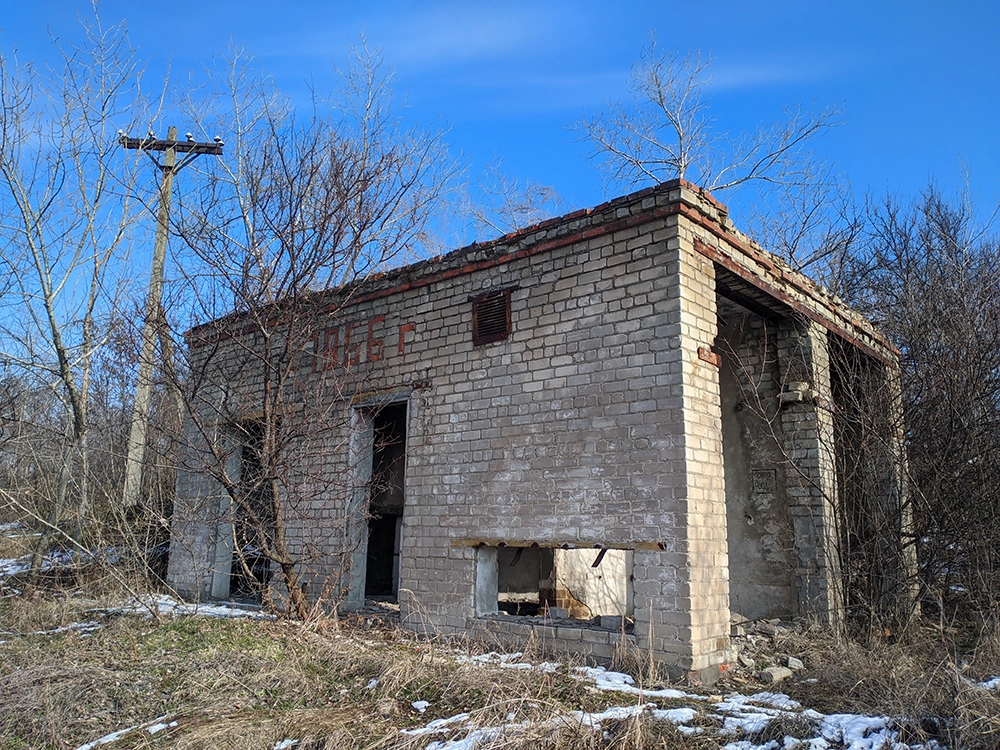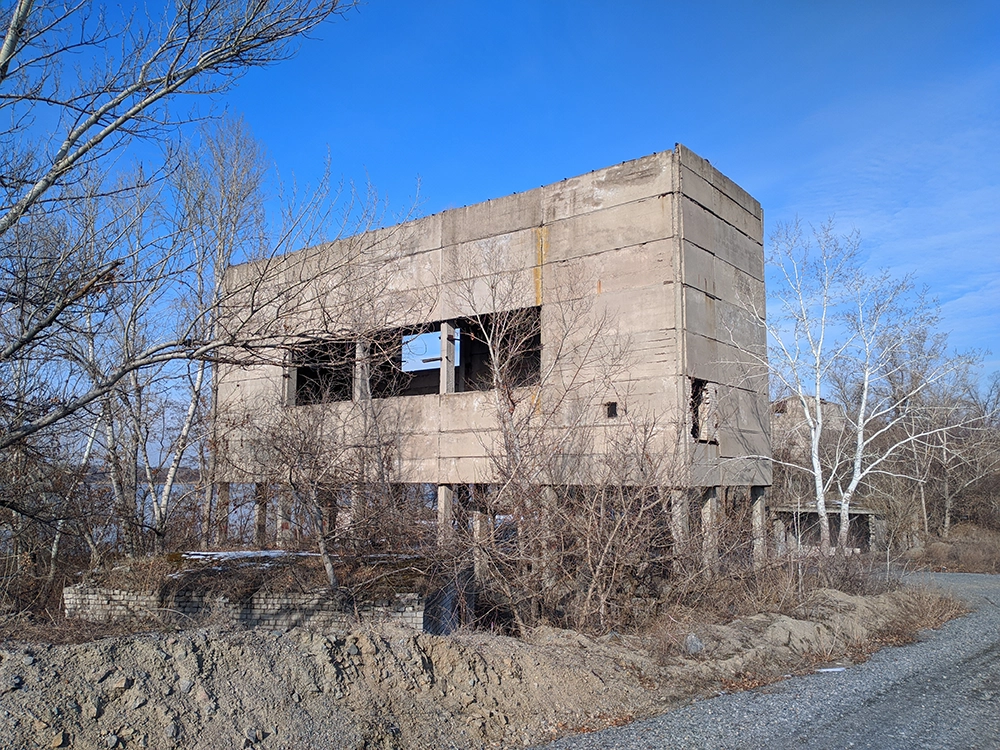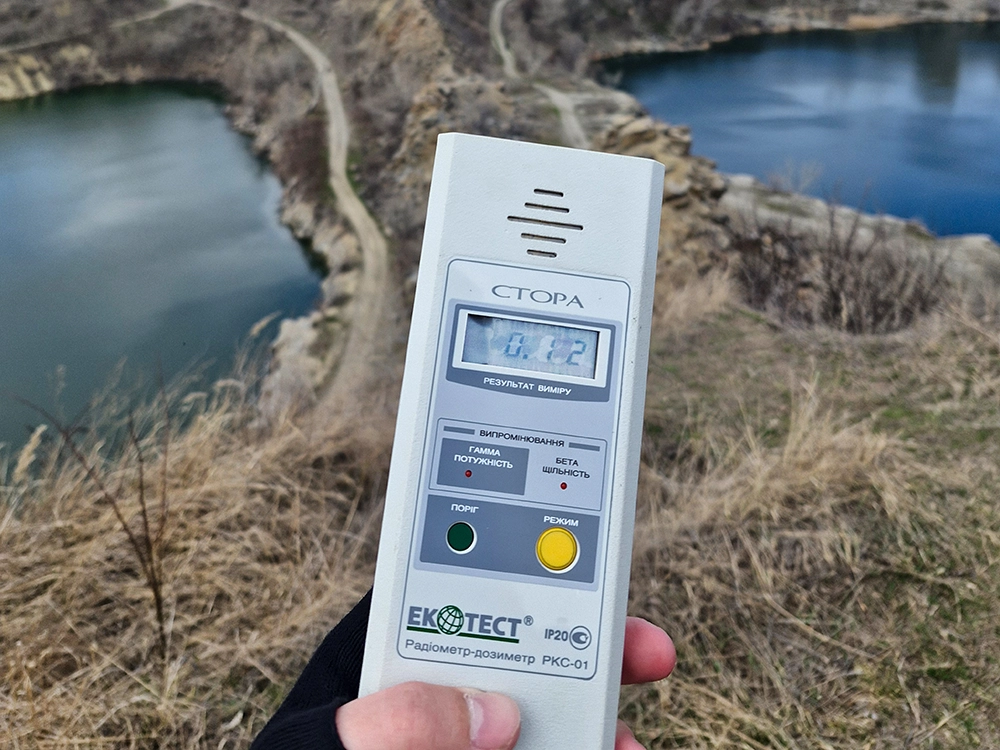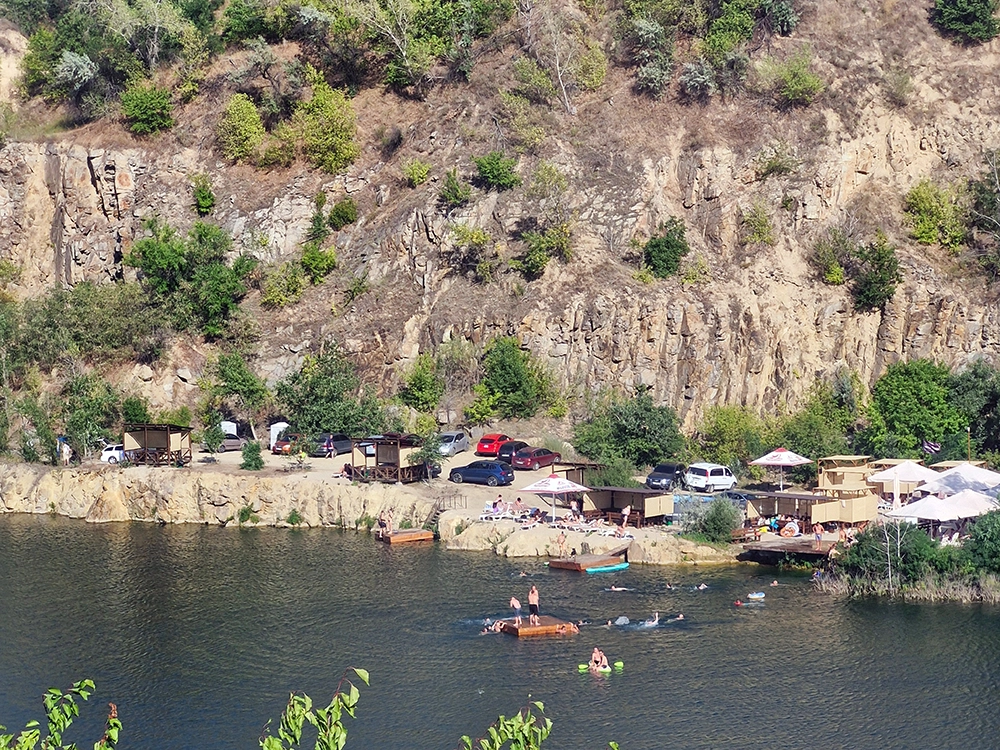
Found photographic film. Taromsky quarry
Abandoned and flooded granite quarry – Dnepropetrovsk region, Ukraine.
This short message is a recollection of my first encounters thirty years ago, and a few refutations of rumors… Some kind of local history trolling 😉Why refutations? Therefore, all these rumors differ from my personal memories. I will also show you some rare Lo-Fi photographs of the Taromsky quarry.
Found photographic film
As a child, I really wanted a camera. The first camera was “Smena 8m” (this is a very cheap and unreliable camera), and taking photographs in the crisis of the 90s was very difficult – it was impossible to get film, photo paper, or reagents, especially for an ordinary teenager. I remember how cheaply I bought half a box of very expired (it is not known in what conditions it was kept) Svema 64 from a friend and was glad about it. I photographed film after film, and put it back in the box, because I couldn’t develop it (I didn’t have anything, and I didn’t know how at that time). So the films accumulated, and some were lost in time and space.
About 15 years ago, in the trash at home, I found some kind of black and white. film, and decided to develop it with what was at hand. I didn’t feel sorry for her because I wasn’t sure that it was my film or that there was anything on it. I found some expired reagents and somehow hastily developed them. As my childhood friend said: “it’s askew and crooked – as long as it’s alive” (Dan, if you’re reading this, greetings and hugs to you).


Imagine my surprise when I saw the image on the negatives and began to recognize landscapes and images familiar from childhood in the frames. Yes – it was my film and these were my memories.
The film depicts our adventures in the then still active Taromsky quarry. I went there with a friend (those were our first industrial-tourist experiences), and then I took my sister there, and we found a place for my father to go fishing.
I felt a little nostalgic and put the film back in the box, along with other videos, and again forgot about those memories for 15 years, because printing low-quality photos was somehow embarrassing…
Taromsky quarry to my memories
Over the past week, several of my friends have been visiting the abandoned Taromsky quarry. The former industrial territory with limited access has become an attractive landscape and tourist site of local importance. Two deep, mysterious lakes and rocky shores attract divers, cyclists, fishermen and picnickers. But I remember this quarry completely differently.
But let me look a little further in time. Even before my personal memories.
In the place where the quarry is now, there once was a path (now Mostovaya Street), along which private estates were located closer to the banks of the Dnieper. Some of the granite rocks here came ashore, so the locals knew about the free building materials and little by little they took stones for their own construction.
To explain how this object developed and fell into decay, I use materials from the site of interactive historical maps of blogger Artem Kostyuk OldMaps.dp.ua
This is what the area where the Taromsky quarry is now located looked like in 1941 https://oldmaps.dp.ua/
This is what the future quarry looked like in 1943 https://oldmaps.dp.ua/
Since the 1941 aerial photograph is not very clear and it is difficult to tell whether any activity is taking place at the quarry, I will add a couple of interesting newspaper clippings (sorry for the quality – it is what it is) from Alexei Adamchik’s media archive.
On the left is a clipping from 1941 with a small advertisement printed on it – the following is a quote:
“The Taromsky granite quarry of the Dnipro River Shipping Company “DURP” is looking for:
– Mining engineer or technician for the position of technical supervisor, mining foreman;
– Security guard;
– Senior accountant and assistant accountant;
All applications should be sent to Dnipropetrovsk… (the rest is illegible)”
On the right is a clipping from August 27, 1961, from which we learn an interesting fact – here is the quote:
“How can we best overcome a rocky wall?” wonder the young climbers, students at the Dnipropetrovsk Welding Technical School. “After all, experienced climbers first feel the walls with their eyes, and only then with their hands and feet. Where do young miners plan to climb sheer cliffs? In Crimea? In the Caucasus? No. On the western outskirts of the regional center, in the Taromsky quarry. The rocky cliffs above the Dnieper have become a favorite training spot for climbers, their “local Caucasus.” Text: I. Katselson
What does this information tell us?
- Firstly, it becomes clear that industrial extraction of stone and gravel and their delivery by water transport had been planned since 1941.
- Secondly, as early as the 1960s, the quarry attracted extreme sports enthusiasts and active tourism lovers.




In the 1950s, geological exploration was carried out, the estates were resettled, the path was moved higher up the hill and open-pit mining began to extract granite and gravel for the growing construction needs of two large cities – Dnepropetrovsk and Dneprodzerzhinsk. The demand for material grew, the quarry grew in a north-western direction along the bank of the Dnieper – this is how the second working appeared.
Taromsky quarry in 1970 https://oldmaps.dp.ua/
The country was experiencing a construction boom, the horizons went deeper, and subsequently the pits became lower than the water level of the mighty Dnieper; this was risky because the workings approached the edge of the shore. The miners decided to expand production towards the hill, so in 1970 they began to build a bypass road, and then the path was again moved even higher up the hill.
Taromsky quarry in 1972 https://oldmaps.dp.ua/



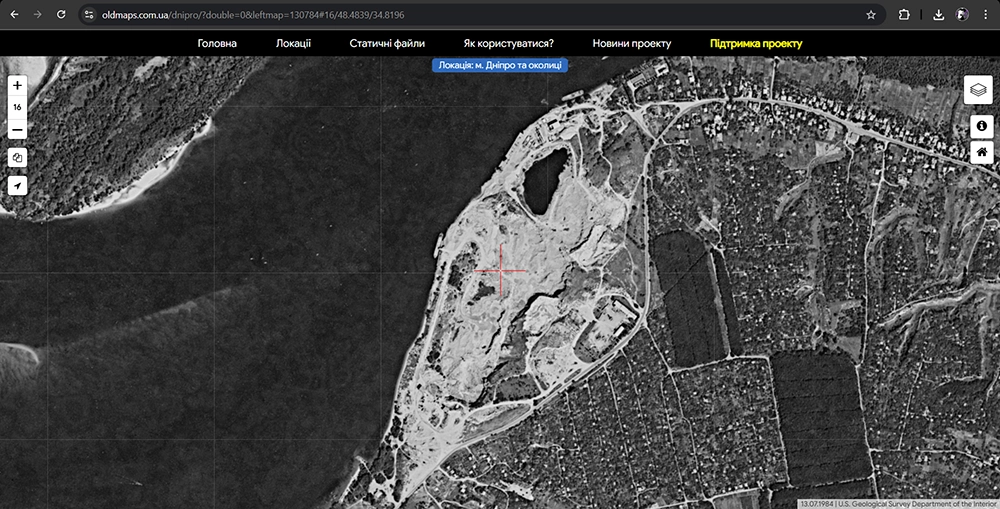
In 1974, the old path, which ran close to the quarry, gradually began to be swallowed up by workings. But decades of blasting work make the granite even more cracked, so water begins to appear somewhere at the bottom of the quarry.
There are rumors (“people talk, but people don’t lie” (c)) that the quarry stopped working in 1991 because they reached the springs and the workings were almost immediately swallowed up by water. So I want to refute these rumors!
Firstly, water in any mine workings is commonplace, and such problems have long been solved by collecting water in sumps and pumping out the required number of pumps. Water began to appear in the workings of Taromsky in the late 1960s and early 1970s. Here, for example, is an aerial photograph from 1975. Look closely – you can already see small lakes at the bottom of the workings.
Taromsky quarry in 1975 https://oldmaps.dp.ua/
Secondly, in my personal opinion, the water in this particular quarry is not spring but river, because, as I wrote above, regular blasting operations contributed to the infiltration of the Dnieper waters. Apparently, during these years the need for construction decreased because granite mining temporarily ceased. Therefore, by 1980, both quarry openings were filled with water.
Taromsky quarry in 1980 https://oldmaps.dp.ua/
But there is one “but”! Several granite quarries operated near Dnipropetrovsk, and they continued to operate, while this one ceased operations and was even flooded with water.
I had a hunch that needed checking out, that the granite from here was mostly taken to Dniprodzerzhynsk. I asked my fellow history researchers from the city of Kamenskoye (community ALTERKAM) about this, and they confirmed that most of the crushed stone for large construction projects during that period was indeed obtained by Dniprodzerzhynsk from these mines. This was the reason for the last drainage and restart of production in these mines.
I get the impression that some users of the OldMaps.dp.ua service believe that the quarry has been flooded since the 1980s, but this is not the case. In the mid-1990s, I walked along the very bottom of the workings myself. This means that it was flooded and continued to operate at least twice.
Most likely, in the second half of the 1980s, it was decided to continue the work, so the water was pumped out. According to satellite images (yes, that’s right—in those years, images were already being taken by satellites, albeit in monochrome), between 1982 and 1984, engineering work was carried out to pump water out of the northern mine. By 1984, it was almost dry. You can track all the layers of images of this location yourself on the oldmaps.com.ua service.
I cannot yet confirm this with satellite images, but until the 1990s, water was pumped out of the southern mine as well, because in the early 1990s, equipment was already operating in both mines and granite was being extracted. I saw both workings in operation and even went down into them, because the site was almost unguarded and there were almost no workers there outside working hours.
What follows are my personal memories.
Taromsky quarry, my memories
I remember the Taromsky quarry like this.
In the 1990s, I spent every summer (and sometimes part of spring and autumn) in Sukhachevka. All these years I have heard warning signals, industrial explosions and all-clear signals. Sometimes there were up to three explosions a day. We were interested – so we went (outside working hours, or weekends – that is, only during safe times) to look at what was happening there.
At the bottom (bottom) of the quarry, drilling rigs and large excavators worked; near each working (there were two), crushing complexes and screens worked, which distributed the crushed stone into fractions. KrAZ 256 dump trucks were constantly driving towards the rumbles, which were filled with gravel, and they took it away somewhere.


The workings were divided into horizons, like terraces. As we walked along the horizons, we came across stones with holes from wells through which explosives were placed, or stones with marks drawn by geologists. In some places there was a chain of concrete shelters, where they hid from the debris of explosive equipment during work. Near the rocks and especially at the base of the quarry it was very hot and stuffy even in the evening, because the granite stones heated up in the sun and gave off the accumulated heat for a long time.
On the south-eastern side there were small administrative buildings and farmsteads with workshops for mechanics who serviced tractors and excavators. There is still a concrete pier near the shore on which a portal crane worked, loading dumps on a barge with a grab bucket. But I never saw him work. The pier was deep, so we went there to fish for gobies.
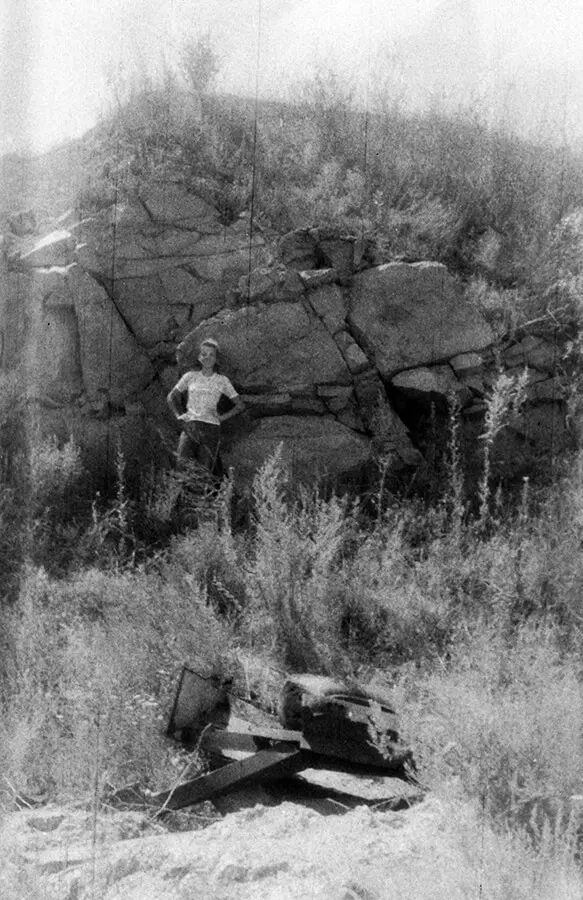


Opposite the pier on the left bank there was a reserve with a “bird market” of river birds (gulls, terns, ducks, storks and herons), so that during the day the bird violence could be heard very loudly even across the river bed. But even here there were plenty of birds – sometimes partridges, frightened by someone, rose from the tall grasses near outbuildings. A little further downstream, near the shore, there was a half-sunken barge aground.


From the hill above the quarry there was a view of the Dnieper and the Orilsky Nature Reserve (opposite, on the left bank). We walked up that hill at night – at this time a fantastic landscape opened up to us, like in the paintings of Arkhip Kuindzhi “Ukrainian Night”, but to the moonlight reflected from the river, distant industrial silhouettes and lights of the DMZ were added.
This is exactly how I remember this place.


When did work end?
Although some people claim that the last year of operation of the Taromsky quarry was 1991, the quarry worked until the mid-1990s, one of my acquaintances, an explosion specialist, confirmed to me. Then came the crisis of the 90s, large construction projects stopped throughout the country, the need for large volumes of granite disappeared, so gradually everything here began to fall into disrepair, was destroyed, plundered. The pumps were turned off and the water gradually filled the workings, absorbing horizon after horizon until the level reached the river waters.
This is how the former industrial area turned into an amazing landscape formation.
In 2010, I returned here with an expensive modern camera. But that is another story…


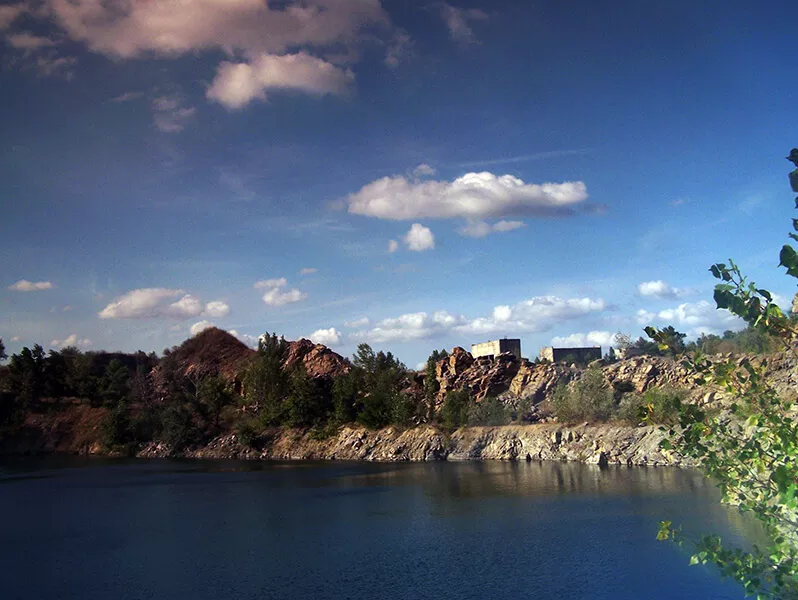
The current state of the Taromsky quarry is as follows: both “bowls” are completely flooded and have turned into two clean lakes. Some infrastructure facilities have already been completely destroyed, while others still stand abandoned or in disrepair.
Friends from the stalker community even checked the radiation background here in March 2025 – the STORA RKS-01 radiometer-dosimeter showed that the overall radiation background was within normal limits. Specifically, 0.12 µSv/h was the reading on the hill above the workings, and the highest reading was recorded directly on a granite boulder on one of the horizons of the workings (closer to the Dnieper River) – 0.20 µSv/h.
As for tourism, I don’t know if rock climbing is practiced there now. But the guys here enjoy jumping off the rocks into the water. Of course, these bodies of water attract divers, fishermen, and ordinary beachgoers. Some tourist infrastructure has sprung up on one of the horizons—businessmen have set up gazebos, barbecue grills for a fee, and drinks and snacks at speculative prices.
An interesting fact about the local fauna. Our colleague in industrial research, Kirill-Navigator, noticed small freshwater jellyfish while swimming in the lakes that formed in the “basins” of the quarry.
The first jellyfish appeared in this section of the Dnieper River back in the 1990s. My father used to fish here and said he had seen jellyfish in fresh water. At the time, I was skeptical about this information, so the next time my father brought us a live jellyfish in a jar to show us—as proof of his words.
How did this species get here? The explanation is quite logical.
They ended up here with river-sea vessels (back when the Dnieper was a fully-fledged shipping artery for the country). — at sea, ships could take on water ballast (probably along with jellyfish) to balance the ship’s roll (this is a technical norm for uneven loading of the ship). In the river, they could discharge the water ballast.
Therefore, some jellyfish have adapted to the Dnieper River water over time.
But the fact that jellyfish swim in the Taromsky quarries proves my theory that the water here does not come from underground sources, but specifically from the Dnieper River.
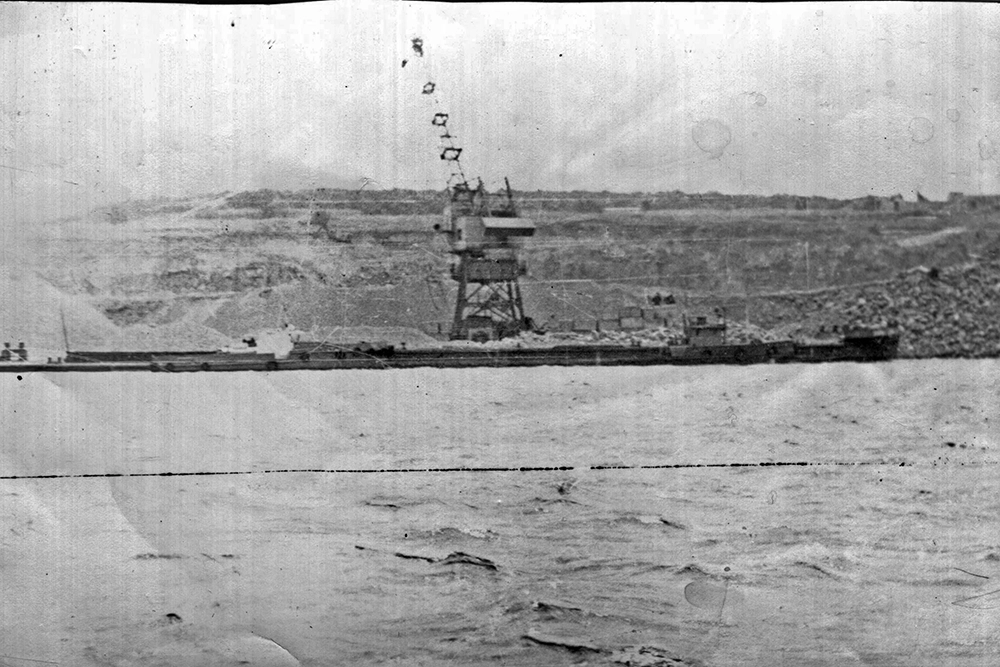

How do I see the future of this post-industrial site?
It is unlikely that granite will be mined here on an industrial scale in the future. Although this option is possible (if the water is pumped out again), I am sure that most of the granite deposits in the developed area have already been mined, and they will not allow the quarry to be expanded (yet again).
As an architect, I see enormous tourist and recreational potential in this location. It has incredible landscapes, interesting active terrain, and two unique bodies of water.
Of course, there is already some kind of “local tourism movement” here, but it’s nothing significant.
This site should be developed comprehensively—a tourist base should be created. It would be even more interesting to create an “extreme professions training center” here—divers, rescuers, industrial and mountain climbers could be trained here, and various rescue missions could be practiced. There could also be a sports base where paragliders, divers, swimmers, kayakers, and SUP boarders could train, and there is the possibility of laying out a couple of bike routes (mountain bikes) for different levels of difficulty. A water ski tow (cable tow) could be installed here, and airsoft ranges or shooting ranges could be set up.
There is potential here — all that is needed is desire, a unified concept, and investment.
